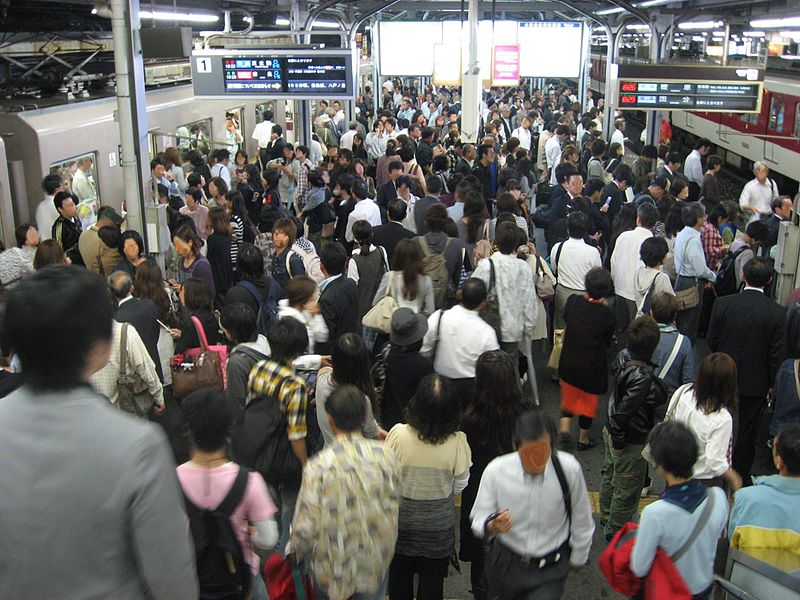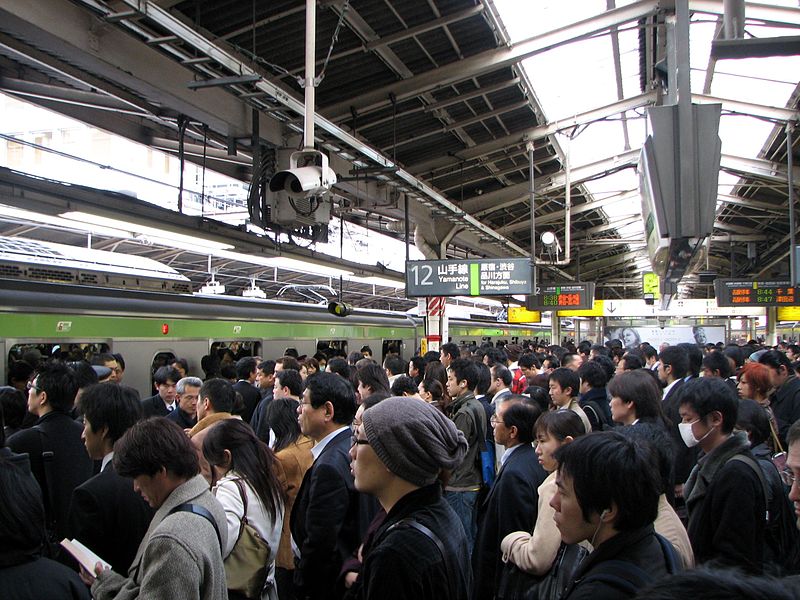The image of squished passengers being pushed into overcrowded trains is an iconic image of Japan, especially Tokyo.
A recent article in the Japan Times’ Yen for Living [2] blog suggests that Japan's employee transportation allowance system may be in fact be responsible for the country's infamous “commuter hell.”
For a variety of reasons, many employers in Japan's affluent and densely populated Pacific Seaboard axis stretching between Tokyo and Osaka subsidize the substantial cost of train and bus tickets for regular, full-time employees.
Tokyo region's massive transportation network has created dense rings of commuter towns that are home to millions of office workers who must travel into the urban core at the same time each morning. The 32.5 million residents of the Greater Tokyo Metropolitan area rely overwhelmingly on public transportation: almost 57 percent of all travel [3] in Tokyo is done on trains and buses, and during peak rush hours metro lines can reach 200 percent capacity [4].
For full-time workers, at least the cost of commuting to work is bearable. According to a 2009 report [5] by Japan's Ministry of Health, Labour, and Welfare, 86 percent of Japanese companies provide employees with a travel allowance.
The ministry report explains that the practice of employers subsidizing employee transportation costs was adopted during Japan's postwar economic boom. As the suburbs expanded ever outward from downtown Tokyo, commutes became longer and train fares more expensive — too expensive for employees to shoulder on their own (unlike in North America where employees are expected to subsidize commuting costs through vehicle ownership).
By the 1960s as Japan entered its era of rapid economic growth and affluence, paying for travel costs was one way companies were able to enhance employee compensation. Travel allowances were a way of distributing economic gains equally without necessarily dramatically increasing pay.
As a result, today many Japanese employers cover commuting costs for full-time employees, many of whom have daily commutes of two hours or more. Travel allowances have come to be expected. These days, most job seekers want to know whether or not a potential employer offers a transportation allowance.
Employers are not legally compelled to provide a travel allowance for employees, but offering a travel allowance has a powerful effect on whether or not an employer can attract talent.
 [6]
[6]Evening rush hour, Tsuruhashi Station, Osaka. Image by T. Hara. CC BY-SA 3.0 via Wikimedia Commons
According to the Yen for Living article [2], the postwar adoption of the employee transportation allowance system (tsukin teate) has led to the dense urbanization that in turn has created “commuter hell”:
But inadvertently or not, the tsukin teate system has contributed directly to the concentration of businesses in major cities, thus exacerbating the problem of long commutes and over-crowded public transportation […] But while transportation expenses are not legally mandated, they are regulated. Companies can write them off as business expenses, but only up to 100,000 [yen] a month per employee (equivalent to US$1,000). If an employee’s commuting costs exceed 100,000 [yen] in a month, the excess is subject to tax as if it were income.
According to the Ministry of Health, Labour, and Welfare survey of 211 companies, about half of 77 companies in the survey with less than 300 employees capped the employee travel allowance at 100,000 per month.
Another 30 percent of companies in this cohort cap the amount a 50,000 yen per month. The report doesn't mention what the remainder of the 211 companies surveyed pay for employee transportation allowances.
There are approximately 4.2 million small, medium, and large companies registered in Japan. Just 0.3 percent of these companies — about 120,0000 — are considered to be large or “enterprise” businesses.
The ministry's report on travel allowances (by relying reporting on the practices of 77 companies of 300 or fewer employees) omits a great deal of data. It's possible that conditions have changed since the boom times of rapid economic growth.
The Yen for Living article questions just how many employees across the country are actually receiving 100,000 yen to cover commuting expenses. Instead, it's the relatively cash-flush companies clustered along the main transportation and industrial artery stretching between Tokyo and Osaka that can afford to subsidize travel.
Rural companies cannot keep up, leading to increasing migration to Tokyo and the cramped cities of the industrialized Pacific Seaboard. The sheer density this migration has caused over the past 50 years has led to Japan's infamous “commuter hell.”
Non-Japanese commenters on the Yen for Living blog article also questioned the wisdom of providing employee transportation allowances:
If employees had to pay their own transportation expenses, which is the case in most developed countries, they would naturally find work that is as close to their homes as possible or move their residence to within a comfortable commuting distance of their work place.
However, on the Japan Times’ Facebook page, a Japanese commenter responded to these comments by saying:
This person has not lived in Japan obviously, for most of people the allowance is approx $100-$200, which is not that much considering how expensive housing costs can be.
Another Facebook commenter asked [7]:
Why don’t more people live closer to their jobs? Because Japan’s cities are already pretty crowded and the rent is ridiculous. Why live closer to work when the tradeoff is a higher rent for a smaller place?
Other commenters expressed doubts that the employee travel allowance was solely responsible for Japan's infamous overcrowded commutes, and that Japan's “commuter hell” might not even be all that unique. On Facebook, Saku Takakusaki wrote [8]:
I don’t know if that commuting allowance is causing the problems mentioned in the article. Large American and Canadian cities are crowded on weekdays and almost dead on weekends because of people coming to work from outside of those central areas.
On the Japan Times’ website, user “rolento” commented [9]:
I guess the writer has never been to china or other asian countries. millions of asians are not paid travel allowances and STILL lives at least 1 hour from their office.
Carol Ruth Kimmel [10] compared the situation to transportation in New York:
Americans don’t get compensation for commuting, but we still have “commuter hell” in New York.
Other commenters pointed out that a commuter allowance is the only way for some employees to be able to afford to work in Tokyo, unless there is a change in thinking about how people work. Shikibu Watanabe argued [11]:
Commuter allowance is necessary for those who live on an average annual salary of JPY 4m and are forced to live in suburbs because they can’t afford the rents in Minato-Ku or Marunouchi. What’s the alternative? Commute by car? Great idea. More congested roads, more pollution. I don’t see the point of this article.
Kelvin Hui wrote [12]:
It goes against the work culture in this country but the concept of “work from home” needs to be introduced here.
Danny de Meyer echoed Hui's comment [13]:
Why don’t companies allow remote working? Home working? Why always ask the employees to adapt?
Based on these responses, employee transportation allowances seem indispensable to working in Japan. And, with the 2020 Tokyo Olympics on the horizon, it appears as though more and more people will continue to cram into Tokyo. Some thought must be put into relieving the subsequent “commuter hell.”
